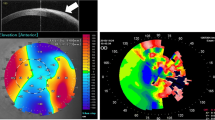Abstract
Aims
To evaluate the effect of pterygium surgery on intraocular lens (IOL) power and ocular biometric parameters and to evaluate the factors affecting these parameters.
Methods
Twenty-eight eyes of 25 patients diagnosed with pterygium were evaluated. Axial length (AL), mean keratometry (Sim K), K1, K2, anterior chamber depth (ACD), corneal astigmatism, and ocular biometry parameters were obtained with a dual Scheimpflug analyzer. Pterygium sizes (horizontal, vertical) were measured manually, and pterygium height was analyzed with anterior segment optic coherence tomography. IOL power was calculated according to SRK/T, SRK II, Hoffer Q, Haigis, and Holladay formulas. Limbal conjunctival autograft was performed in all patients after excisional pterygium surgery. Preoperative and postoperative 1st month measurements were analyzed and compared.
Results
The mean age of the patients was 51.5 ± 13.8 years. Mean horizontal pterygium length, vertical width, height, and percentage extension of the pterygium were 2.4 ± 0.9, 4.7 ± 1.0 mm, 297 ± 93µm, and 20.2 ± 7.2%, respectively. There was a significant increase in Sim K, K1, and K2 values postoperatively. Postoperative IOL power was significantly lower than preoperative values in all formulas. The change in IOL power after surgery was −0.3 ± 0.6D in the SRKT, −0.3 ± 0.5D in SRK II, −0.4 ± 0.7D in Hoffer Q, −0.5±0.7D in Haigis, and −0.3 ± 0.7D in Holladay 2 formulas. The change in IOL power has a moderate positive linear correlation with the horizontal and vertical sizes of the pterygium and a high positive linear correlation with the percentage extension of the pterygium.
Conclusions
Pterygium surgery causes a significant decrease in calculated IOL power obtained with all formulas. It becomes more pronounced with the increase in the size of the pterygium.

Similar content being viewed by others
References
Rezvan F, Khabazkhoob M, Hooshmand E et al (2018) Prevalence and risk factors of pterygium: a systematic review and meta-analysis. Surv Ophthalmol 63(5):719–735. https://doi.org/10.1016/j.survophthal.2018.03.001 (Epub 16 Mar 2018. PMID: 29551597)
Pham TQ, Wang JJ, Rochtchina E, Mitchell P (2005) Pterygium, pinguecula, and 5-year incidence of cataract. Am J Ophthalmol 139(6):1126–1128. https://doi.org/10.1016/j.ajo.2004.12.004 (PMID: 15953456)
Kamiya K, Shimizu K, Iijima K et al (2015) Predictability of intraocular lens power calculation after simultaneous pterygium excision and cataract surgery. Medicine (Baltimore) 94(52):e2232. https://doi.org/10.1097/MD.0000000000002232 (PMID: 26717362; PMCID: PMC5291603)
Mohammad-Salih PA, Sharif AF (2008) Analysis of pterygium size and induced corneal astigmatism. Cornea 27(4):434–438. https://doi.org/10.1097/ICO.0b013e3181656448 (PMID: 18434847)
Yasar T, Ozdemir M, Cinal A et al (2003) Effects of fibrovascular traction and pooling of tears on corneal topographic changes induced by pterygium. Eye (Lond) 17(4):492–496. https://doi.org/10.1038/sj.eye.6700377 (PMID: 12802349)
Kheirkhah A, Safi H, Nazari R et al (2012) Effects of pterygium surgery on front and back corneal surfaces and anterior segment parameters. Int Ophthalmol 32(3):251–257. https://doi.org/10.1007/s10792-012-9560-2 (Epub 7 Apr 2012 PMID: 22484701)
Oltulu R, Demirel S, Sarac O, Ozer MD (2013) Evaluation of corneal and anterior chamber changes following pterygium surgery using a Pentacam Scheimplug system: a prospective study. Semin Ophthalmol 28(4):206–209. https://doi.org/10.3109/08820538.2012.760617 (Epub 25 Apr 2013 PMID: 23617535)
Koc M, Uzel MM, Aydemir E et al (2016) Pterygium size and effect on intraocular lens power calculation. J Cataract Refract Surg 42(11):1620–1625. https://doi.org/10.1016/j.jcrs.2016.09.015 (PMID: 27956289)
Tang Y, Qian D, Wei L et al (2020) Influences of the three-dimensional parameters of pterygium on corneal astigmatism and the intraocular lens power calculation. Sci Rep 10(1):5017. https://doi.org/10.1038/s41598-020-61959-3 (PMID: 32193493; PMCID: PMC7081302)
Gasser T, Romano V, Seifarth C et al (2017) Morphometric characterisation of pterygium associated with corneal stromal scarring using high-resolution anterior segment optical coherence tomography. Br J Ophthalmol 101(5):660–664. https://doi.org/10.1136/bjophthalmol-2016-308685
Han SB, Jeon HS, Kim M et al (2016) Quantification of astigmatism induced by pterygium using automated image analysis. Cornea 35(3):370–376. https://doi.org/10.1097/ICO.0000000000000728
Gumus K, Erkilic K, Topaktas D, Colin J (2011) Effect of pterygia on refractive indices, corneal topography, and ocular aberrations. Cornea 30(1):24–29. https://doi.org/10.1097/ICO.0b013e3181dc814e
Maheshwari S (2007) Pterygium-induced corneal refractive changes. Indian J Ophthalmol 55(5):383–386. https://doi.org/10.4103/0301-4738.33829
Kim SW, Park S, Im CY et al (2014) Prediction of mean corneal power change after pterygium excision. Cornea 33(2):148–153. https://doi.org/10.1097/ICO.0000000000000036
Author information
Authors and Affiliations
Corresponding author
Ethics declarations
Ethics approval
Prior ethical approval from the Sakarya University Institutional Review Board (IRB) (E-71522473-050.01.04-6010) was taken. The study was performed in adherence to the 1964 Declaration of Helsinki.
Consent to participate
Written informed consent was obtained from each subject or from the parents of each subject in the study.
Consent for publication
Patients or parents of patients signed informed consent regarding publishing their data.
Informed consent
Written informed consent was obtained from each subject or from parents of each subject, in the study.
Conflict of interest
The authors declare no competing interests.
Additional information
Publisher's Note
Springer Nature remains neutral with regard to jurisdictional claims in published maps and institutional affiliations.
Rights and permissions
About this article
Cite this article
Dogan, E., Cakir, B., Aksoy, N.O. et al. The effect of pterygium surgery on intraocular lens power and ocular biometric parameters. Ir J Med Sci 191, 2399–2403 (2022). https://doi.org/10.1007/s11845-021-02830-w
Received:
Accepted:
Published:
Issue Date:
DOI: https://doi.org/10.1007/s11845-021-02830-w




